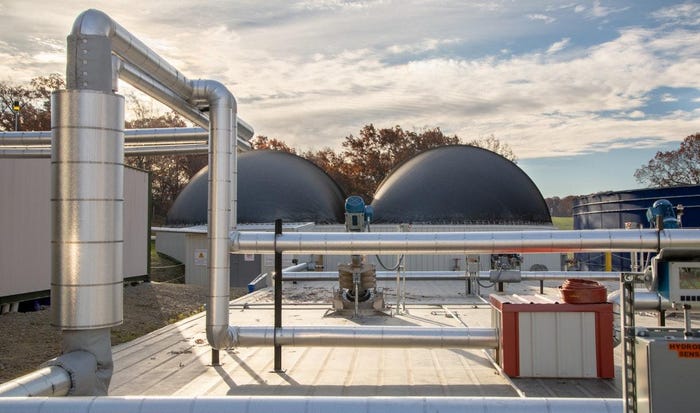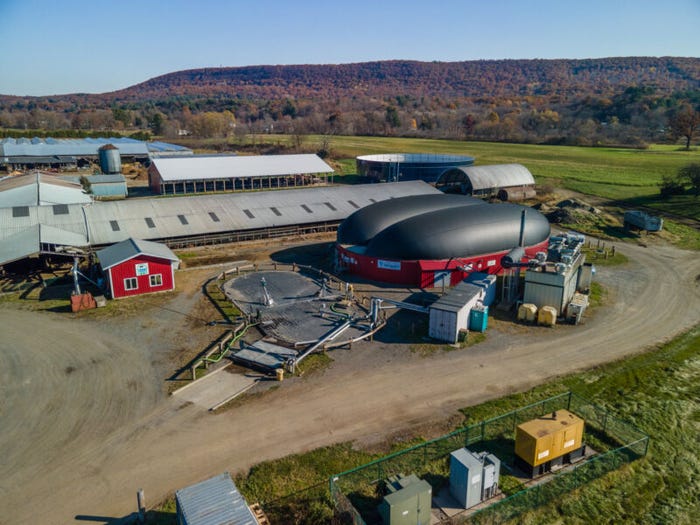Vanguard’s Roadmap to Circularity Through Renewable Natural Gas
As Vanguard Renewables marks its tenth year in the anaerobic digestion business, it has grown from a few sites in New England to 32 digesters operating across eight states, with plenty more in the pipeline for the near future.
Vanguard’s birth was spurred by the convergence of two policies in Massachusetts: a ban on the landfilling of food waste and a net metering law that incentivized biogas projects. The company landed a few deals to build, own, and operate anaerobic digesters in that state to make electricity from food waste, with a little manure mixed in to enhance the biological process.
Massachusetts proved a good starting place for these co-digestion projects, but once that market was nearing saturation, and a large digester project in Vermont had lifted off, it was time to branch out because few states mandated food waste diversion.
Eyes turned to California, where policy was playing out that brought a new opportunity for different project types and a different beneficial use.
“After we built out the portfolio in Massachusetts, we were not sure we could get the volume of food waste we needed to expand our business. It was fortuitous at that time that California created a marketplace for low-carbon intensity gas for transportation fuel through its low-carbon fuel standard. [a law incentivizing investments in clean renewable fuels to cut greenhouse gas emissions],” says Neil Smith, Vanguard CEO.
So began the venture into dairy farm projects since cow manure yields the cleanest output. The opportunity to scale came fast; Dominion Energy wanted renewable natural gas (RNG) for the grid and teamed with Vanguard to build a nationwide network of dairy farm-powered anaerobic digesters.
As the new ag niche continues to leap ahead Vanguard has opened another chapter. This newest chapter actually picks up where the team started—pumping up the food waste digestion model. By now food and beverage manufacturers were taking onus to find sustainable ways to manage their waste rather than landfill it. Like with the Dominion farm digester projects, the plan is to take this revived food waste model national.
“So, we started in food waste. We pivoted to ag. And now we are circling back to bring the food business we began in Massachusetts to the rest of the country, with the benefits of lessons learned through each leg in the journey,” Smith says.
A Food and Beverage Materials division takes care of hauling and processing, equipped with food depackaging machinery and elaborate odor control and filtration systems.
At the same time, hundreds of millions are going into the ag digester sites, with plans to spend multiples of that to beef up food waste projects. All total about a $2 to $3 billion pipeline should add more than 100 locations by 2028.
Growing while staying nimble has required learning brand new skills, a combination of art and science— food waste collections; manure management; creating networks; and selling RNG while managing complex biological and chemistry processes.
Sometimes unexpected roles land in the team’s lap. John Hanselman, chief strategy officer at Vanguard, recalls a pandemic scenario where the company fielded a flood of calls from arenas, large venues, bars, and just about any place with kegs of beer. Forced closures rendered the spirits unsalable or drinkable.
“We didn’t have a tool to mass decant kegs and we couldn’t find a commercially available one to work with our system. So, we worked with our beer distributor to come up with a contraption that can decant eight kegs of beer at a time. It was because of their ingenuity and our encouraging our team to be creative problem solvers that we could devise the system that we still use today,” he says.
The team continues to adapt, sometimes taking new paths.
“We used to think we were in the anaerobic digestion business. But now we are in the decarbonization solution business and the circularity and waste reduction business,” Smith says.
Materials management is a large part of the job on both the front and back end. The food waste projects alone process 200 to 300 tons daily with 200 to 300 pounds of digestate exiting the system.
Residual solids from the tonnage of processed manure taken off farmers’ hands becomes bedding for herds. The remaining liquid becomes a low-carbon digestate that the farms use as an ultra-low-odor fertilizer in place of the manure.
In time Vanguard hopes to take the circularity concept further by offering food waste generators RNG from their waste.
A few customers already tap into this closed loop model. Cabot sends waste from butter manufacturing to Barstow’s farm in Massachusetts, then buys the energy created from it, which powers its butter facility. This is one of Cabot’s favorite stories, says…
Read More: Vanguard’s Roadmap to Circularity Through Renewable Natural Gas



